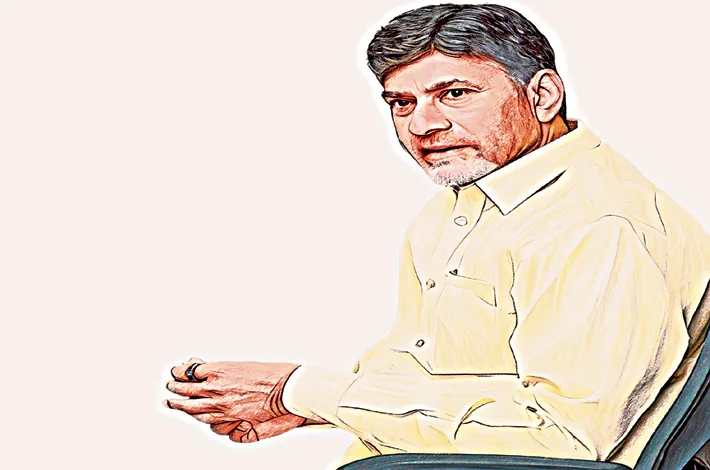P4 and the Dream of a Poverty-Free Andhra Chandrababu’s Garibi Hatao
14-07-2025 12:00:00 AM

2.47 lakh families have been adopted by 25,678 Margadarsis across 26 districts. That’s not just statistics; that’s a quarter of a million lives touched by someone who cares
KIRANMAYI TUTIKA / VJM DIVAKAR I amaravati
In the bifurcated Andhra Pradesh state which became bankrupt in all sectors and aspects under the dreadful regime of the past, a new hope is stirring. It’s called P4—Public-Private-People Partnership—a grand name for a simple idea: what if the people themselves, not just the government, took up the fight against poverty? What if every hand that has, reached out to a hand that has not? Chief Minister N Chandrababu Naidu, a man whose political life has been a curious blend of pragmatism and vision, has thrown this question to the people of Andhra. And they are answering.
What is P4?
P4 is not a scheme, not a sarkari yojana with fat files and fatter promises. It’s a platform, a bridge, a conversation between those who have and those who need. Launched on March 30, 2025, on the auspicious day of Ugadi, the Telugu New Year, P4 is Naidu’s bold wager: that the people of Andhra—citizens, corporates, NRIs, and even celebrities—can come together to lift 5 lakh families out of poverty by August 15, 2025. Not with handouts, but with heart. Not with charity, but with solidarity.
We walked through the streets of Vijayawada last week, past the small shops selling jasmine and jalebi, past the auto-rickshaws honking their way through life, and we heard whispers of this P4. A schoolteacher told us how she’s mentoring a family of five, helping the children with books and the mother with a sewing machine. A software engineer in Hyderabad shared how he’s funding a surgery for a child he’s never met, through P4’s donor platform. And in a village near Guntur, a Gram Sabha gathered under a banyan tree, picking out families who need help—not because a politician said so, but because the village knows its own.
This is P4’s soul
The ‘Adopt-a-Family’ model, where a ‘Margadarsi’ (a guide) takes a ‘Bangaru Kutumbam’ (a golden family) under their wing. It’s not about writing a cheque and walking away. It’s about sitting down with a family, understanding their dreams, and helping them stand on their own. It’s about teaching a boy to read, helping a father start a small business, or ensuring a grandmother gets her medicines. The second arm of P4 is a donor platform, where NGOs post urgent needs—school fees, medical bills, or even a goat for a widow to start a livelihood—and anyone can step up to help, with every rupee tracked online.
Already, the numbers are humming with promise. Over 2.47 lakh families have been adopted by 25,678 Margadarsis across 26 districts. That’s not just statistics; that’s a quarter of a million lives touched by someone who cares. From Visakhapatnam to Kurnool, from the rice fields of East Godavari to the tech towers of Amaravati, P4 is spreading like a monsoon breeze.
But let’s pause and ask: is this too good to be true? Can a state, battered by years of political tug-of-war and economic strain, really pull this off?
Chandrababu Naidu, with his trademark spectacles and tireless energy, believes it can. He’s no stranger to big ideas. In the 1990s, his Janmabhoomi movement brought people and government together to build roads, schools, and dreams. P4 feels like its heir—a sharper, tech-savvy version for a new Andhra. Naidu calls it “an ecosystem of empowerment,” where the government’s job is not to control but to connect. “We won’t offer funds,” he says. “We’ll build the platform, and society will take charge.”
There’s something refreshing in that. For too long, we’ve looked to Delhi or state capitals for solutions, as if poverty is a puzzle only bureaucrats can solve. P4 flips that script. It says: you, the teacher, the businessman, the NRI sipping coffee in New York—you have a role. It’s a call to the heart, not just the wallet. And Naidu is doubling down. On July 18, in the gleaming new capital of Amaravati, he’s hosting 200 top influencers—corporate honchos, real estate tycoons, even film stars—for a special dinner. He’ll lay out P4’s roadmap and ask them to join the movement. Imagine that: a Chief Minister dining with the elite, not for photo-ops, but to nudge them toward a cause bigger than themselves.
Yet, questions linger. Can a voluntary model scale up to erase poverty by 2029, as Naidu dreams? Will the privileged really step up, or will P4 remain a feel-good story for the few? And what about accountability? The government has tied up with NGOs and built an online dashboard to track every donation and outcome. Gram Sabhas and Ward Sabhas decide who gets help, keeping politicians at bay. But human nature is tricky—favoritism, apathy, or fatigue could creep in. Naidu, chairing the P4 society with Deputy CM Pawan Kalyan as vice-chair, will need to keep the machine well-oiled.
We think of a woman we met in Anantapur, Sarojamma, whose husband died leaving her with three children and no land. A Margadarsi, a local shopkeeper, adopted her family through P4. He helped her start a small vegetable stall, paid for her eldest daughter’s tailoring course, and checks in every week. Sarojamma’s eyes lit up when she spoke of her daughter’s first stitched blouse. “This is not just money,” she said. “This is someone believing in us.”
That’s what P4 is betting on: belief. Belief that poverty isn’t just a number but a story that can change. Belief that a state of 5 crore people can act like a family. Naidu’s vision is audacious, but it’s not impossible. If 25,678 Margadarsi can adopt 2.47 lakh families in months, what could a million Margadarsi do? What could a movement do?








